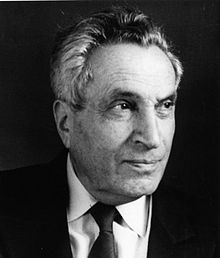Aram Bagratowitsch Nalbandjan
Aram Nalbandyan Bagratowitsch ( Armenian Արամ Բագրատի Նալբանդյան , Russian Арам Багратович Налбандян ; born January 1 . Jul / 14. January 1908 greg. In Karakilis ; † 24. January 1987 in Yerevan ) was an Armenian physical chemist and university lecturer .
Life
After the early death of his father, Nalbandjan grew up with his grandfather, a farrier , and attended the local school.
Nalbandyan studied 1926-1930 at the University of Yerevan in the physico - mathematical Department of Education - Faculty . After graduation, he was sent to the new Leningrad Institute of Chemical Physics of the Academy of Sciences of the USSR (AN-SSSR) (now NN Semenov Institute of Chemical Physics), where in 1931 he began his traineeship with NN Semenov. He examined the mechanism of hydrogen - oxidation as an example of branched chemical chain reactions . With his experimental results he confirmed NN Semjonow's theory. In 1935 he received his doctorate as a candidate in chemical sciences .
In 1941, at the beginning of the German-Soviet War , the Institute for Chemical Physics was evacuated to Kazan . There Nalbandjan investigated methods of producing explosives , while his wife Bella L. b. Sinajewa was the medical director of the army hospital. In 1942 Nalbandjan received his doctorate in chemical sciences there . In 1944 the institute returned to Moscow . In 1947 Nalbandjan was promoted to professor. In 1949, together with WW Wojewodski, he published the monograph Mechanism of Hydrogen Oxidation and Combustion , which was awarded the Mendeleev Prize in 1950 . In 1957 he became head of the Laboratory for Oxidation of Hydrocarbons . In addition, he headed the 1951-1959 Physics - Chair of the Moscow Technical University of Communications and computer science . In 1959, together with NS Jenikolopow, he published the popular science book Formaldehyde , a material for plastics . In the same year he took part in the 8th Mendeleev conference in Moscow.
In 1959, at the suggestion of the Presidium of the Armenian Academy of Sciences , Nalbandyan founded the Laboratory for Physical Chemistry of the Armenian Academy of Sciences. In 1960 he joined the Communist Party of the Soviet Union . In the same year he became a Corresponding Member of the Armenian Academy of Sciences with full membership in 1963. In 1967 he left Moscow and became Academy Secretary of the Chemistry Department and member of the Presidium of the Academy in Yerevan . In 1975 the Laboratory for Physical Chemistry was reorganized as the Institute for Physical Chemistry of the Armenian Academy of Sciences, of which he was director until 1987, when he became Academy Secretary of the Department of Chemistry and Geology , and which has been named after him since 1993.
Upon invitation, Nalbandjan gave guest lectures in 1966 at Canadian universities, in 1973 as a Gauss professor at the Institute for Physical Chemistry at the University of Göttingen and in 1980 at the Université catholique de Louvain . In 1979 he was accepted by the New York Academy of Sciences . 1980–1987 he was co-editor of the Hungarian international trade journal Oxidation Communications .
In 1988 the Soviet Post honored Nabandjan with a stamp. A scientific conference on physical chemistry was held in Yerevan to mark the 100th birthday of Nabandjan.
Honors
- Badge of Honor of the Soviet Union (1945)
- Medal "For heroic work in the Great Patriotic War 1941–1945" (1946)
- Mendeleev Prize (1950) for studying the mechanism of hydrogen oxidation and combustion
- Order of the Red Banner of Labor (1954 and 1977)
- Large Gold Medal of the Exhibition of Economic Achievements of the USSR (1965)
- Certificate of Honor of the Supreme Soviet of the Armenian Soviet Socialist Republic (1967)
- Anniversary medal "In memory of the 100th birthday of Vladimir Ilyich Lenin" (1970)
- Honored Scientist of the Armenian Soviet Socialist Republic (1974)
- State Prize of the Armenian Socialist Soviet Republic (1976) for studies of the elementary processes in slow gas reactions
- Order of Lenin (1986)
Individual evidence
- ↑ Armenian National Academy of Sciences: Арам Багратович Налбандян (accessed August 12, 2016).
- ^ IA Wardanyan: Aram Bagratowitsch Nalbandjan (Russian) . Hajastan, Yerevan 1988, p. 6-10 .
- ↑ AB Nalbandyan . In: Chemical Journal of Armenia . tape 61 , no. 3-4 , 2008.
- ↑ Арам Багратович Налбандян . In: Армянский химический журнал . tape 40 , no. 2 , 1987, pp. 137-138 .
- ↑ В. В. Воеводский, А. Б. Налбандян: Механизм окисления и горения водорода . Moscow 1949.
- ↑ AB Nalbandyan Institute of Chemical Physics (accessed August 15, 2016).
- ↑ On the 100th birthday of the academic Aram Nabandjan (Russian, accessed August 15, 2016).
| personal data | |
|---|---|
| SURNAME | Nalbandjan, Aram Bagratovich |
| ALTERNATIVE NAMES | Նալբանդյան, Արամ Բագրատի (Armenian); Налбандя́н, Ара́м Багра́тович (Russian) |
| BRIEF DESCRIPTION | Armenian physical chemist and university professor |
| DATE OF BIRTH | January 14, 1908 |
| PLACE OF BIRTH | Karakilis |
| DATE OF DEATH | January 24, 1987 |
| Place of death | Yerevan |
